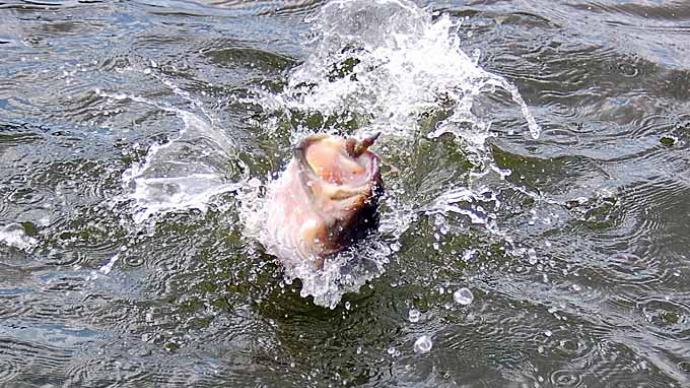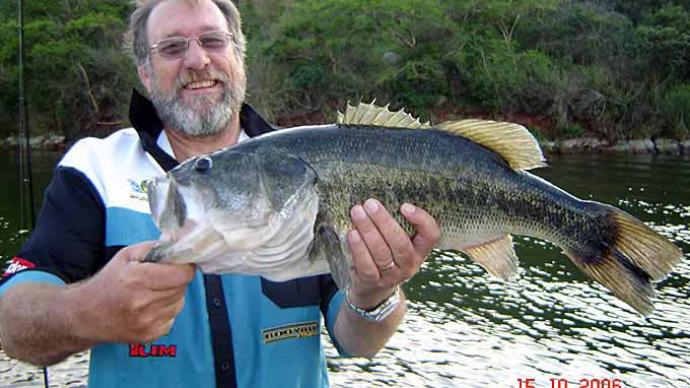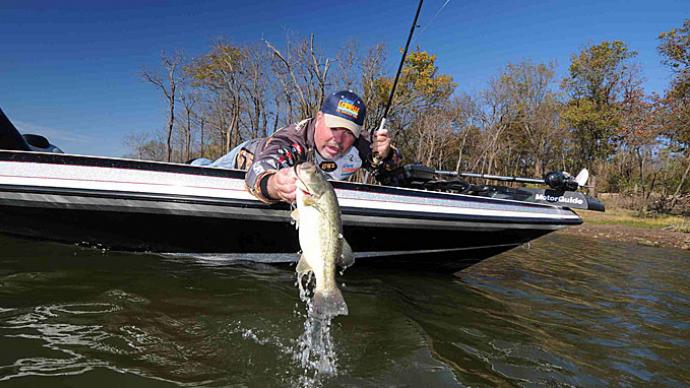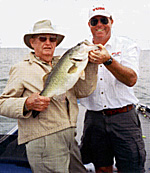
When plastic worms first came out, the ways of using them were limited because most of the hooks and weights were designed primarily for bait fishing. The first rigs used straight shank sproat hooks with the point exposed and clinch weights (a clinch weight had a slot down its length for the line, with tabs on each end that folded over to hold it to the line).
Some of the first plastic worms came pre-rigged with one to three or four hooks and the line threaded through the worm. We also rigged them like a live bait rig with a bell weight. although everyone thinks that split shot finesse rigs are something new that was one of the basic rigs we started with in the beginning. The jig head-type hook rig was also one of the basic rigs.
We were limited in weight and hook design, so we experimented. The primary line at the time was braided nylon and then monofilament became popular. The jig head-type hook rig was also popular. The biggest problem was using these worm rigs in the trees, lily pads, grass and cattails. I'm not sure who was the first to come up with the Texas rig, but by reversing the hook and embedding it into the worm, it put a whole new outlook on worm fishing. Before we had access to slip sinkers or bullet weights we would cut the wire out of bell weights and use them for our Texas rigs. Those weights were more available in west Texas.
Texas rigs opened up a lot more water for everyone. Now you could drop the worm down into thick brush or heavy grass and be able to get to those hot spots. There has been a lot of development in hooks, weights and other accessories since the first Texas rig hit the water. Hooks have been designed to hold the worms better, either with the offset hook or barbs on the neck of straight shank hooks. We now have available wide gap offset, wide gap straight, light wire and heavy wire or bronze and nickel - just about any type hooks for any size plastic bait.
Bullet weights are the most commonly used weight for Texas rigs and you can get them in the old standard lead, brass, steel or Tungsten Nickel. You can enhance your Texas rig with a brass weight and even glass beads like the Venom Glass Rattle. In some cases you may want to peg the weight with Peg-It rubber peg wedges or the old way, with a toothpick. Several companies make a screw-lock type weight that screws onto the worm to keep it secure.
The Texas rig is simple in its form. Simply slide a weight onto the line and tie on the hook. Now take a worm or lizard and push the point of the hook into the head end of the bait about 1/4- to 3/8-inch and out one side. On a lizard the best way is toward the belly and on a worm away from the tail curl.
Pull the hook through and turn the hook 180 degrees pulling the eye of the hook down until it reaches the head of the bait. Hold the bait where the bend of the hook meets the bait body, hold the bait at that point and bring the bait up to the point and push the point through at that area. Now pull the point back into the body of the bait and bury the point just enough to make it weedless.
With a Texas rig you can stay in touch with the structure and move the bait through cover to find that bass you've been in search of. The weedless Texas rig is one of the most versatile ways of working heavy cover. You can also work open areas along a bank, creek channel, bridge pilings or rocks as well. When working some of these more open areas, try tying on a small grub or crappie jig about a foot above the rig. You may catch two fish at a time this way. This will give the illusion that something is chasing the "baitfish" (worm or lizard) and it works great.
Use as light a weight as you can cast to work the cover. This will give you a better feel as you pull the rig over the structures or bottom.
There are also times when you will use a Texas rig without a weight. I like using a Texas-rigged 10-inch Power Worm or 6-inch Gene Larew craws without weights in lily pads and grass. This gives a slower fall, but the bait is heavy enough to cast, hit the target area a little quieter and slip the bait right down nose-to-nose with ol' Miss Bass.
With the Texas rig you can cast or flip to specific target areas accurately. It is typically best to cast past the target you want to fish and then work the bait back into the target area. This is probably the most versatile way of utilizing all of the different plastics available today. It's not just a worm rig, either. Lizards, tubes, centipedes or French fry-type worms, grubs, jerkbaits and craws all make the grade with the Texas rig.
Once you move into deeper water or fish in heavy wind, it becomes hard to feel a Texas rig as it contacts the structure or to feel the strike from a bass. In this situation you need to move to the Carolina rig.
The original Carolina rig used a bullet or egg weight, which goes on the line first (usually 1-ounce) and then you would slide on a glass bead. The bead makes noise when the weight hits it and also protects the knot on the swivel. Tie a swivel on a short leader (about three feet in length, though some people use even longer on occasion) and then tie the swivel with the leader to the main line. Next tie on your hook of choice to the end of the leader.
The reason you follow that order is if you use a Palomar knot, you'll run into a problem in any other order. The standard in the past was to use a 1-ounce weight and this works great in deep water. The best way to work your rod is to sweep it to the side keeping in contact with the bait. If you're working shallow water, a lighter weight works better. In grass, a 1/2-ounce weight doesn't hang up as bad as a 1-ounce. Like the Texas version, the Carolina Rig has had a lot of development in weights, hooks and other accessories to make rigging easier. There are several pre-fabricated rigs. The Easy Rig, Carolina Short Cut, and Carolina Clacker Rig are just a few. Kathy Magers developed the Easy Rig. With this product you simply add a leader and a hook and you're ready to fish.
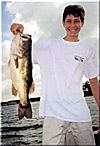
A quick way of making a Carolina rig is using a Speed-O-Bead, a Carolina Keeper, or the Lunker Lure Carolina Rattle. All of these take the place of a swivel. The Carolina Rattle not only works to hold up the weight, but the rattle is an attractant for the bass. With the Speed-O-Bead, you wrap the line around the bead and snap it into place to hold the weight at any place along the line. The Carolina Keeper works in the same way, except you squeeze the Keeper and put the line through it, then slide up the line to the length of leader that you need for the situation. All of these work well and each can be used in most types of fishing.
Like using different size weights, it becomes a matter of personal choice. Most anglers just use bullet weights for all applications, but some of the other styles make it easier to fish certain structures. Flex-O-Sinker (a long nylon tube with split-shot inside and swivels on either end), Mojo, Projo brass and XPS Cylindrical weights (1/4-inch round and long, skinny slip sinkers) all work great in the grass. Because they are slim, they slide through the grass easier than a bullet or egg weight. The egg weight works better in rocky areas than bullet weights because the egg weights tend to roll off of the rock rather than wedging between the rocks.
For anglers that like jigs, Lunker Lure makes a bullet weight jig for Carolina rigs that gives you a second hook and lure to attract bass.
I prefer light wire offset nickel hooks on my Carolina rigs. Any hook will work, but the light wire hooks allow the bait, like Uncle Josh's Fossil Lizard or a Venom Boogie Bug to float, dart and glide better than a heavier one. With a heavy weight the Carolina rig works great in the wind and in deeper water, but if you drop the weight size, there are a lot of other areas you can fish. Also the length of the leader can vary from one foot up to six or seven feet, depending on the vegetation or structure.
If you are fishing grass you may want the leader long enough to allow the bait to bounce along the top of the grass, or shorter to dart through the middle area. The length of the leader is a matter of personal preference and adapting to the fishing situation. If you start with 2-1/2 to three feet and adapt shorter or longer from there, it will give you a good length to work most cover.
The Carolina rig is more than just a deep-water rig. Like working grass along the shore, there is usually a gap of clear water between the shore and where the grass starts. I use a lighter weight (1/8- to 3/16-ounce) and a shorter leader, about 18 inches. You can cast on shore at the edge of the water and slowly drag or hop the lure through the clear water into the grass. Work it slowly up to the edge of the grass and then reel in quick to avoid disturbing the grass. Repeat as you go down the bank. It's amazing how something sliding in the water from shore will arouse bass.
A boat dock fished with a Carolina rig and a two- to three-foot leader can be awesome. Cast near the shore and work it back along the dock, bumping its beams and stopping for a few seconds. This is a great technique.
Don't be restricted by traditional thoughts on the types or styles of lures to use on a Carolina or Texas rig. Any of the Uncle Josh Pork in Plastics or pork frogs, or other trailers will work if you use a weedless style hook. Even small crankbaits can be excellent choices to tie onto a Texas or Carolina rig in deep water. Experiment, be different and see if it doesn't pay off for you.
Bonita is sponsored by Mercury Motors, Bowie Marine, Hamby's Protectors, Solargizer, Falcon Rods, Bob's Machine Shop, Minn Kota, OutdoorTexas.com and Tournament Chasers.


